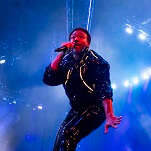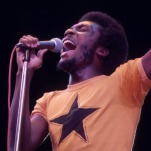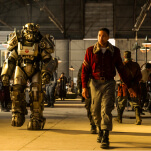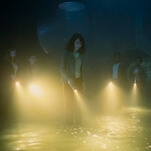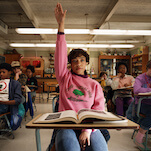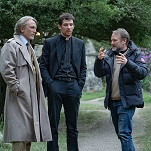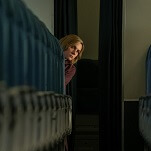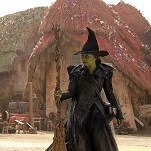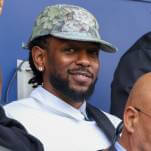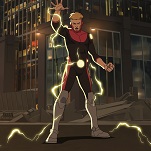Derek Waters and Jeremy Konner on Drunk History’s first four episodes
Though Drunk History began as a web series way back in 2007, it only transitioned from ’net to network earlier this summer, as the show began its first season on Comedy Central. Now complete, this first official season found the series tackling both wordy, vomiting comedians and complex U.S. history with aplomb. The show’s creators, Jeremy Konner and Derek Waters, found themselves thrust into the world of television production, working with bigger budgets and tighter schedules, but were still able to produce a charmingly janky work, complete with hokey costumes, awkward line deliveries, and authentic sneeze attacks. For the first part of this A.V. Club walkthrough, Waters and Konner talk us through the show’s transition to television, as well as its stops in Washington D.C., Chicago, Atlanta, and Boston.
“Washington D.C.” (July 9, 2013)
The A.V. Club: How did Drunk History go from web series to TV show?
Jeremy Konner: We had been doing Drunk History as a web series for a long time, and I think both of us decided to try it as a TV show not exactly knowing how it was going to go at first. We had a bunch of ideas on how to make that transition and we just went to Will Ferrell and Adam McKay’s company [Gary Sanchez Productions] and said, “We’d really like to develop this with you.” We told them the idea of us traveling around, and they immediately thought that was great and we took that to Comedy Central and sold it.
Then we all of a sudden had to deal with all this money and this budget and it was incredible, but scary because we were dealing with the greatest crew in the world and everybody was like, “It’s rough and it’s Drunk History;it’s got to be kind of homemade.” People in every department were like, “We’ll make you the greatest costumes and the greatest sets” and we’re like, “Hold on! We still need to capture some of this feeling.”
Derek Waters: It’s hard to say “homemade” and not make it sound like we want them to do a bad version of their job. But we wanted to keep that feel of what the web series had. When we were doing it for YouTube and Funny Or Die, it was Jeremy and I and maybe five others. But with the TV show, all of a sudden you have this huge crew. It was definitely nice, but overwhelming. We were like, “Oh, shit! We’re making a TV show!”
AVC: Once you get the green light, it has to be a challenge to figure out, “This is how we go from inception to delivery.”
DW: You take an idea that’s like, “Oh, this could be fun” for the web series, and that’s really the only reason we were making it. But with TV, it’s like, “Oh, wait this is a job now? People are getting paid? There’s food here that our parents’ friends didn’t buy for us? No way!”
One of the things in the transition that really helped us was figuring out that it was okay to do three separate stories in one episode as long as it had this unifying idea of a city. We were really struggling at first with, “Can we really do one story for 20 minutes?” That seemed nuts to us, but we didn’t want it to feel like a series of sketches so that was really the toughest challenge. I think what we came up with was really great for launching it into the television world, but still with the same feeling.
JK: And I would say, “How do you make a five-minute idea a half-hour? How will this idea not get old?” Really, the biggest transition was broadening the world of history so we would be able to do stories about Abraham Lincoln, but also do stories about Patty Hearst and Elvis Presley. History is bigger than guys in white wigs signing declarations of independence.
AVC: On that tip: How did you decide to put the Elvis story in the Washington D.C. episode? Part of it is certainly set in Washington, but how did you arrange what went where?
DW: We have great researchers, and one of the researchers, Seth Weitberg, was so good that now he’s one of the co-producers. All three of us went through really cool, rare stories, but we didn’t have any angle of what city we were going to do. We wanted to just find the best stories and then sort of go, “Oh, where does that make sense? Let’s shoot D.C.” Actually, we were going to do Memphis as a town, but we didn’t have enough stories for Memphis, so we moved Elvis while we were shooting it.
JK: We’d landed in Nashville and we were about to drive half a day to Memphis, but if we could figure out a way to make the Elvis story not Memphis and put it in Washington D.C., then we could make a Nashville episode, which we were really excited about because I think the Nashville one, in many ways, is the heart of music. That was really fun to make that decision on the road. It was nerve-wracking, but the results were really good.
DW: And while we were shooting D.C., we did Watergate, our first story, with our great narrator Matt Gourley, who knew so much about Nixon and Watergate. With all these stories, we get lucky with our narrators and their knowledge.
JK: Matt grew up in a house that was a few houses down from the house Nixon grew up in in Torrance or Whittier. He’s always had this very strange connection to Richard Nixon, and his whole life he’s been sort of obsessed with Nixon and Watergate. He knew that story and brought it to us. This was still in the early stages where we were just asking people we knew, “What stories do you like? It can be anywhere.” We didn’t know exactly which cities we were going to, but when we were talking to people, we just opened it up and he was one who was really like, “I know Watergate, can I do Watergate?” And we said okay.
AVC: Is that how it works most of the time? The narrators come to you with story ideas?
DW: The goal has always been to ask people about the moment of history that they’re most passionate about or that you think more people need to know about. Then, they’re genuinely excited because when you’re around someone that’s been drinking, when they tell a story you don’t know, they get very, very excited to tell you, like, “You’ve got to hear this!” We like to use people that are genuinely intrigued by the story and know it well. And we’ll always give them documentaries or films to look up little specific things, but we never want to make it feel like homework for anybody.
JK: Eric Edelstein, who did Elvis, is also another great example of somebody who did not need us in terms of research. That man is an encyclopedia of Elvis.
AVC: Did all of the stuff in the Elvis segment really happen? Did Elvis really run down a plane?
DW: He didn’t actually get on the tarmac. I don’t exactly know if he was walking or running, but he was in the airport with the Memphis mafia. They also had guns, but we didn’t shoot that. Anyway, they ran down the airport, flashed the badge, and got on the plane. They were after this guy named Hamburger James who Elvis paid to get late-night hamburgers for him. He’d actually stolen Elvis’ “kit” and the kit was full of naked pictures, drugs, jewelry… it was a lot of things.
JK: The other thing I wish made it in that story was that when Elvis went to meet Nixon, he brought a package with him. It turned out that Elvis Presley walked into the White House with that box with a gun inside of it and he gave Nixon a gun and no one ever searched Elvis.
AVC: The Abraham Lincoln segment in this episode is great. Allan McLeod’s flat affect is amazing and Adam Scott is really great in the sketch as well.
DW: That’s one of my favorites just because it’s a pure Drunk History story and Allan is such a great narrator. We always wanted to do [John Wilkes] Booth as an actor, but then, when we were researching, we were learning all this other stuff about his brother Edwin. There was actually a part of the story that we had narration for and we were going to shoot. Remember, Jeremy? Edwin saved Abraham Lincoln’s son off a railroad track?
JK: He didn’t know it was his son. He picked up this kid who fell on the tracks and, later, it turned out to be Lincoln’s son that he saved.
AVC: How do you decide who plays what role? How do you decide that Adam Scott would be a good John Wilkes Booth, for instance?
DW: I don’t know. I’m very confident with our casting choices. We’ve been pretty dead on about who looks like him and who will play him the best. Sometimes with things like—and not to jump ahead—but Winona Ryder in the Boston story, there was definitely a little Crucible inspiration where we wanted to see her dressed like that again. Sometimes we think, “Who in their life or their acting career is a little bit like this?” And we get lucky, because most of them we know. I’d say 80 or 90 percent of people we hired, we already knew and the rest we just had a casting director pick them out, but we’ve been very lucky with people wanting to do it.
AVC: You’ve used a couple of people twice, like Bob Odenkirk and Jack McBrayer. How is that organized? Do you put them in multiple costumes and scenarios in one day?
DW: Every short is one day. One day. And with Bob and Jack McBrayer, we just shot them both in one day. Jeremy and I met through Bob, so he’s a good omen for us.
JK: I was editing a show that Derek created with Simon Helberg and Bob called Derek And Simon. It was a pilot for HBO.
AVC: Since you mentioned editing, you’re dealing with rambling drunk people and you have to make whatever they say into a seven-minute story, and keep it true to the actual history. How true to the narrators’ thought processes is what the audience sees? When Matt Gourley threw up right in the middle of his story, is that really when he threw up?
DW: With every storyteller, we shoot about four to five hours, so that’s a lot of B.S. that you’ve got to cut out. With Matt Gourley, that happened about 10 minutes after we started filming.
We’ll fib timing of things like that but, for the most part, we’ll stay pretty true and not do editing tricks. We have the best editors. You can’t watch that show without going, “Who the hell edited this?” because it’s very hard to make a drunk person make sense.
JK: I think the most we’ve ever had to lie or screw around with [with] words is when someone gets it wrong, but we don’t find out until later, when its like, “Oh, no! They said 1876, but it was 1875.” That kind of stuff, we don’t want to be wrong. We’re okay being lenient with the time compression of things, and I think most History Channel stuff even has moments it goes a little easy on, but with dates and names, we definitely want to make things right as best we can.
AVC: What’s the actual shooting timeline like? You show up with booze, and then start shooting? Are people really drunk, or are they exaggerating?
DW: It’s always at their place, and they’re drinking whatever their drink of choice is and it’s a very hard balance for everyone. We try to say have a couple before we get there so you’re a little buzzed, because we like to do the first two or three takes of a somewhat coherent story before they get really drunk, so we’ll at least be able to have something usable. But there are times where we’ll get there and they’re way too drunk or not drunk at all and we know it’s going to be a long night.
AVC: Was there anyone who got too drunk? Kyle Kinane was impressive.
DW: I think I’ve waited long enough to say yes, he was the drunkest.
AVC: Let’s come back to that for “Chicago.” How long is the lag between when you shoot the story with the drunk narrators and with the actors? How do you get them to sync up their mouths?
JK: It was actually a couple a months between shooting the first interview and shooting the reenactment.
DW: When we’re doing the reenactment, there’s no sound when we’re shooting. It’s much like a music video where the audio is playing on a loop over and over again during whatever scene we’re doing. We have it playing on the loud speakers over and over again so we can be shooting and they can sync themselves up while they’re doing it.
Our set often feels like Pirates Of The Caribbean—not the movie, but the ride—because when you’re walking around, you’ll often see an actor say, “No, don’t you tell me this!” then he’ll back up and take a couple steps forward and say it in the exact same way. He’s just rehearsing with this little audio speaker system and his animatronics.
AVC: Before we leave “Washington D.C.,” are there any good stories about shooting that episode?
DW: The TJB sign falling down. You know how Elvis Presley had that “TCB” catchphrase with the flash? The set designer, Eric Archer, made this awesome thing that said “TJB” because we couldn’t use “TCB” and it was Jack Black’s initials. Every time we shot right by that sign, it would just fall down. It was like Elvis marking his territory.
JK: Every single time we shot it, no matter what, it would fall and they’d put it back together.
DW: We’d be standing by that sign the whole day and it wouldn’t fall down until we started filming. That being said, I think Elvis still loves the story.
AVC: And why wouldn’t he?
DW: You’d think he was there.
JK: Some people still think he’s alive.
“Chicago” (July 16, 2013)
AVC: The Haymarket Riot segment in this episode is fantastic. Kyle Kinane is amazing.
DW: Kyle’s a legend. That’s one of my favorites, too, and that’s such a really cool story. You knew a little about it Jeremy, but I knew nothing about it. And I was so intrigued by it. The opening to the show, we call it our love letter, although that’s a cheesy thing to call it. Still, every episode opens with a local talking about their town, and my favorite love letter we have is for Chicago: “Fuck you!”
AVC: You also got the most Chicago-sounding locals in the clip. The guy in the Green Mill with you sounded like one of the Superfans.
DW: That guy, Dave, he’s a pure Chicago man. It was so much fun to shoot in that city. I would like, if we get picked up, to do a part two of Chicago because we love that city and people were so nice to us. Chicago has so much history and so, so much drinking.
AVC: So tell me more about shooting the Haymarket Riot segment.
JK: Nicholas Monsour is our editor, but Ike [Barinholtz] went to high school with him. I’ve known him since I was 15. He’s spent most of his life in Chicago and he was like, “You guys should do that story,” so we looked it up and I had never heard anything about it. I’d heard of a sort of May Day union strike, but I didn’t know the details of anything and I got so excited because the more we started looking into it, the more I realized that no one has ever done anything about it. There have been books written but there are no documentaries we could find, no movies about it, nothing.
AVC: It’s such a big story in Chicago, but it’s also such a big story in punk history, in anarchist history.
DW: It’s really not something Hollywood wants to deal with, that’s for sure. Nobody wants to fund the anarchist movie.
[pagebreak]
AVC: Around the time this episode aired, Kyle and Ike Barinholtz were talking on Twitter about watching the segment. Do the narrators and actors ever meet each other?
DW: There are very few where we’ve had the narrator come by and watch, but unless we’re really close to them, it always makes me, at least, feel a little nervous. After doing this or us and having a shitty day and getting really drunk and telling a story, I want to be able to be like, “Here’s what we’re doing with that” and not like, “Here’s what we’re trying to do with what you gave us.” It can look like we’re making fun of them if they come to the set and we’re just shooting people saying words and they don’t know what they’re saying. We like to wait for them to see the final product.
But some people come, like Natasha Leggero in San Francisco. I really wanted her to come by and see it because she knew exactly what was going on, but with some people we like to wait till we’re finished for them to see it. Then when they meet them, they get so excited. When Winona Ryder met Jen Kirkman, they were in love with each other.
AVC: How do you deal with it when a narrator throws up?
DW: It comes up a lot more than I wish it would. We have a medic named Anna Baltimore, and I’m from Baltimore so I really love her. When someone would get sick, I would help them, and Anna would help them. Still, there’s always that time where you’re like, “Should we be shooting this? Should we be filming them puking like this?” But, as Kyle said, “Puking on Drunk History is like crying on Barbara Walters.” I think Kyle really wanted to puke.
AVC: He was really going for it. He was rolling around on the ground screaming and he had that bandana.
DW: My favorite thing was when we showed Kyle his story, or just him drunk. It was at South By Southwest and his first reaction was, “I don’t have a red bandana.” He couldn’t even remember that bandana. And the text I got the next morning was so great. It was like, “Did I puke on my wall?” I had to say, “Not when we were there.”
JK: We had to stay with him for a long time. We were originally going to go to someone else’s place, but we had to stay there forever because we had to make sure he was all right. He really did push it to the limit, which is not something we encourage.
AVC: Well, you kind of encourage it.
JK: We had to learn the hard way that you can’t tell drunk people that they’ve had enough. That’s a bad, bad idea. I remember we were getting a little worried and we decided, “Kyle, we’re going to take the alcohol away. You’re good, you’ve had enough.” And that became his challenge.
DW: He was just trying to do his job.
“Atlanta” (July 23, 2013)
AVC: In this episode, Jenny Slate talks to her dog a lot, and then the dog shows up in the segment.
DW: Should we have more dogs?
AVC: Oh, tons more dogs.
DW: Should we do more dogs in season two? Dogs and cats everywhere!
JK: I think we could do a good-size B-roll of people and their dogs.
AVC: People talk to their dogs when they get drunk. They’re easily distracted.
DW: Jenny is a cute drunk. She’s definitely the cutest.
Atlanta was a fun episode. Stetson Kennedy is my all-time favorite story that we’ve ever done by far.
AVC: Why?
DW: Because the point of what we always do is to ask, “Why don’t we talk about this guy? Why don’t we know him? Why isn’t Stetson Kennedy just a name that everyone knows?” He was such an amazing man, and it takes so much courage to do something like that.
Our narrator, Mark Gagliardi, pitched me on that story and it’s definitely in my top things that we’ve ever been able to get on camera.
AVC: The sneezing segment in that sketch is amazing.
DW: Jason Ritter, we always say he’s the king of Drunk History. He’s the master. He does it so well every time. He’s such a good actor, but he’s also so good at broad comedy. With most of our stories, the tone is to play it as serious as possible but just be a little more in the subtle world. Something like sneezing might make it really broad comedy, so making it work really excited me and was why I liked that story.
AVC: The Stetson Kennedy story also shines a light on the fact that sometimes what we do is extremely stupid.
JK: It was one of the more talked-about and debated episodes. Going into it, we were thinking that we’re shooting this story that has a lot to do with the Ku Klux Klan and, like, “How funny is this going to be?” We don’t want to do it in a way that’s extremely offensive because they’re really terrible, but we had to figure out how to take what we were reading about, what was really happening at the time and figure out any way to make it funny. We got really lucky because that story is about a guy making fun of them. So that’s the way in.
AVC: Mark is a narrator twice in the season, and he spends a good part of both segments lying on the ground. When you use people twice, do you usually shoot it in one night?
DW: Sometimes. There were some people we had to shoot twice just because they got too drunk or it got too late. Mike Gourley will be doing The Alamo in the season finale, and that one was all shot in one night. When we started, we were doing two narrators a night telling two stories a piece, which was crazy. We had no time.
JK: But we did stop doing that by the end. We were like, “Ehh, one story is enough for a person to tell.” That’s a lot, and it takes a long time.
AVC: How long does it take for someone to tell a story?
JK: It takes like four to five hours because they’re drunk, sure, but also because it’s the story of The Alamo. What we’ve distilled into five minutes is just a short snippet of what he told. We can make an entire hour-and-a-half movie about the story he told. When people really know the subject matter, even though you say, “Yeah, but we kind of want to focus on this” that doesn’t matter because they’ve got to tell you everything, especially when they’re drunk. In the Watergate episode, Matt Gourley wanted to tell us about Nixon’s childhood a number of times and we were like, “That’s amazing. We’d love to know more about that, but this is the Watergate story.”
DW: But when James Atkinson did the MLK/Hoover story, we had him, if I recall, tell three stories that night. We had him tell a personal story, an MLK/Hoover story, and then a story about the zombies.
JK: And the Banana Man.
DW: And the Banana Man! Oh, my God!
JK: He had four. He did the story about his dad who was into zombies, which was an amazing story, then he did a story about getting hit by a car, which is one of the ones you’ll never hear.
DW: It’s a really good story. I hope somehow we can figure out how to make that some day.
I’m trying to think of any more stories about Atlanta. That party at the very beginning where those girls say, “drop it and cross it” is definitely one of my favorite moments.
Wasn’t Atlanta the first city we ever went to, Jeremy?
JK: It was the first city we traveled to when we were traveling, yeah.
AVC: How do you get invited to the parties you film for the show?
DW: We’d ask for improv groups or people in the comedy world in towns who would be open to having a house party at their place that we could go to for the night and we would do the same thing for the bars.
AVC: There’s a guy in The Onion office who was actually in the Boston episode. He’s the guy with the Pokemon cards.
DW: So you know where that was shot, then?
AVC: No. Where?
DW: It was in Austin, actually. We went real cheap. Because we had already shot the Boston episode not knowing we were going to do all this travel and how we were going to do all this, exactly. So we shot the pilot six months earlier, but didn’t include Derek going to parties in the same way and in bars, so we had to redo that somewhere along on our tour and we didn’t have the funds to go back to Boston.
AVC: Was Boston the pilot?
DW: That was the pilot presentation. The original setup was me going across the country in a short bus because I’m 34 years old and I realized I know nothing about my country. But, through trial and error, we figured out that we wanted to broaden the world and make it a history show for you to learn from and not just for dumb Derek to learn from.
AVC: So when you were in Austin, you were like, “Who knows about the Isabella Stewart Gardner Museum art heist?”
DW: Yeah, we were there for South By Southwest and we got a bar and talked to people about the topics we knew we had holes in and needed them filled.
“Boston” (July 30, 2013)
DW: Can we talk about Kirkman? One of our biggest highlights was getting Jen Kirkman back. She’s our queen of Drunk History and defines everything we look for in a narrator. She’s passionate about a moment in history and will do everything she can to let it out. But, since it’s the end of the season and people like the show, I don’t feel bad about saying that Jen Kirkman didn’t know this story. Jeremy found this story, but it really excited Jen and she read up on it and, as you can tell in the final product, got very excited about Mary Dyer and her unmarked grave.
AVC: She cries!
JK: She cries! I remember stumbling across this story and saying, “Derek. Tell me this is not the perfect Jen Kirkman story. She’s going to go nuts when she reads this.”
AVC: And did she?
DW: She definitely went nuts when she read it and she compared the great Mary Dyer to Jim Morrison.
JK: Well, the gravesite.
AVC: Why do you think this was the story for her?
DW: Our goal for every narrator, whether it’s them telling us the story or us telling them the story, is to find out how the fuck have we not been told about this person, how did this person die this long ago, how did this person do something this courageous and we haven’t been taught about them? Mary Dyer was someone that was hidden. People didn’t want you to know what she fought and believed that God is everywhere and not just in the Bible.
JK: Jen Kirkman did the Oney Judge story we did a long time ago and she did the Lincoln/Douglas one, but I think this one fits better with the Oney Judge one because they’re both incredible stories of women standing up to a society where women have no rights. Mary Dyer’s story is an amazing story of empowerment and martyrdom.
DW: And Jen Kirkman is the perfect, perfect candidate for that story. I think any human being would be excited to learn about Mary Dyer, but I think it’s more important to get that story out there in a female voice.
AVC: And you have Winona Ryder playing Mary Dyer.
DW: And Winona Ryder! We talked about casting, that some of these things scream a certain type of person and Winona Ryder in The Crucible—that movie had elements of that type of story and she was unbelievable. She did so much research on Mary Dyer—some she’d already done for that time period—and she was so specific of what type of outfit she’d be wearing. It really helped us going in with drunk narration trying to tell this historical story to have people like Winona Ryder taking it as seriously as possible. That’s kind of the tone we want to always keep.
AVC: And then you have Michael Cera in the same story, but he’s playing an old man.
DW: Exactly. It’s a good balance.
JK: Right. Michael Cera did my favorite thing in like the first episode we did. He put on the wig and said, “Wait a minute. Hold on.” He pulled the wig back an inch just so you can see the front of his hair and he was like “there.” It felt like, in that one moment, he was able to define what Drunk History was and what it became. When he was wearing the white wig in this episode, he, again, pulled it back.
AVC: That same episode, you have a couple talking about the Isabella Stewart Gardner art heist. These guys just seem like a couple of Bostonians. How did you find them?
DW: Boston was our pilot presentation and our original goal was to go into these towns and get history from the locals themselves. It was so much harder than we thought, with good reason. It’s hard to tell a story in general and it’s hard when you’re drunk and in front of a camera crew filming you. But these two, Erin and Michael—I have to look up how to spell their last name. I think it’s Rohr—they’re a married couple we met in a Boston bar. We were doing what we do with everyone, which is asking about a moment in history that you think more people should or need to know about and you love. And they naturally knew so much about this art heist and really wanted to tell us about it.
JK: I remember sitting there with them and they were being really goofy and they were like, “Oh my God, we’re a block away from the art heist, the biggest one in the world!” And I’m like, “What are you talking about?” And then, after that, I think I started getting super into it.
DW: Either way, it was brand new to us and they were very good. They’re the only two locals we ended up using in the entire season.
AVC: Why does Jason Ritter have an eye patch in that story?
JK: That’s one of the things I’m most proud of in our season, because the guy who he is based on had an eye patch and wore a fedora and suits. We never mention it, but that is 100 percent historically accurate.
DW: Also, it should be noted that after we shot it, so much came out about that art heist with Whitey Bulger. More just came out about that story maybe six months ago. Is it that they found the art or they know where the art was, Jeremy?
JK: They say they know where it is and they know who has it, but they’re not releasing it. They’re also saying that the security guard was in on it.
DW: They have a theory that the security guard was in on it, but I read that interview and it just sounds like he was a weirdo. I don’t think he was [in on it], but who knows?
AVC: You also have an interstitial in that episode where a bar fight happens right behind you.
DW: That happened naturally. That was not a staged thing at all.
AVC: It seems really Boston. Everyone was wearing Red Sox shirts. Was it opening day?
JK: That’s when we shot our pilot presentation. It was Patriot Day, it was opening day…
DW: It was the marathon, right?
JK: Yeah, the 2012 Boston Marathon. It was wild. Everywhere we went, people were falling over and fighting.
DW: You probably won’t keep this, but I find it really interesting that there were two things that happened in the Boston episode just out of coincidence. In the Jason Ritter part where we reveal his job description or his title, he’s going through all these files and he gets frustrated that he can’t figure out this case, so he throws his pen down. You hear a sound that sounds just like the pen hitting the table but, in reality, Erin, the female storyteller, put her cup down at that exact same part, and it sounds like the pen hitting the desk. That’s just a nerd thing, but I get excited when those things happen. It happened in the arsonist, too, but I’ll tell you about that when we get there.
AVC: Let’s talk about the arsonist now. This one worked because it was such personal story for Chris Romano.
DW: Jeremy and I have both known Chris Romano for a long time and he’s been trying to make a TV show about the arsonist. Maybe it’ll help doing a Drunk History about it. It’s an amazing, true story and, thankfully, he was up for it. A lot of people would ask, “Well, how is he allowed to talk about it if he was in witness protection?” We didn’t put it in there, but his father has passed away so there’s no links to Chris now.
JK: And Whitey Bulger is in prison.
AVC: You also have a good cast in that one. Connie Britton plays his mom and Nick Offerman plays his dad.
DW: Connie Britton had just done the pilot for Nashville when we shot that, and I was— and still am—obsessed with Friday Night Lights. I had met her a couple years prior and she’d said she would love to do a Drunk History and I said, “I’m going to take you up on that” because I love her. I wish she had a bigger part, but she did so good.
AVC: You could always have her back.
JK: We will find a place for Connie. We have to; we’d be crazy not to.
DW: The synchronicity that happens in that episode is where the little boy sits down on the couch. What sounds like the boy sitting down on the couch is Romano rubbing his microphone.
JK: One of the hilarious things about that episode is that Chris was telling two stories; he was telling the story of the Boston Red Sox breaking the curse, right?
DW: The 2004 Red Sox.
JK: We found this amazing thing out: Sports knowledge is a very specific kind of knowledge and people who are obsessed with sports know details, unbelievable amounts of statistics, that’s what Chris Romano knows. He was rifling off hours and hours of stats. We couldn’t even get past the second game of the playoffs.
DW: One funny thing that happened was that we couldn’t shoot at Chris’ house, so we shot that one in a hotel, but he got home very safe. But when we were in there, he’s getting free drinks, Jack and Coke, from us. He goes to the bathroom, and when he comes back, there’s a knock at the door and it’s someone who works at the hotel and they’re like, “Hi, we have a Jack and Coke.” We’re like, “Okay, thank you. What the hell?” And it happened again after he went to the bathroom. Then we realized that he’s getting on the phone in the bathroom ordering Jack and Cokes. When he’s already getting free drinks!
AVC: That’s something a drunk guy would think is hilarious.
JK: He did also talk for about an hour with his pants off.
DW: Romano. He’s classic for taking his pants off.
GET A.V.CLUB RIGHT IN YOUR INBOX
Pop culture obsessives writing for the pop culture obsessed.


